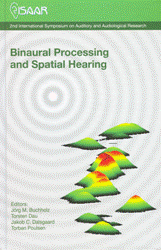Spatial release from masking for sentence recognition in noise
Abstract
The scope of this study is to investigate the impact of a single interfering noise on the binaural intelligibility of sentences. Speech Reception Thresholds (SRT) were assessed using semantically unpredictable short sentences presented in the horizontal plan at an angle x while masked by stationary speech shaped noise at an angle y. The test procedure and results are detailed and a Binaural Better Band per ear Speech Intelligibility Index (SII3b) is compared to the resulting Spatial Release from Masking (SRfM), showing satisfactory correlation.
References
Avendano, C., Duda, R. O., and Algazi, V. R. (1999). “Modeling the contralateral HRTF”, 16th International Conference: Spatial Sound Reproduction, Rovaniemi, Finland, 313-318.
Beutelmann, R., and Brand, T. (2006). “Prediction of speech intelligibility in spatial noise and reverberation for normal-hearing and hearing-impaired listeners,” J. Acoust. Soc. Am. 120, 332-342.
Brand, T., and Kollmeier, B. (2002). “Ef cient adaptice procedures for threshold and concurrent slope estimates for psychophysics and speech intelligibility tests,” J. Acoust. Soc. Am. 111, 2801-2810.
Bronkhorst, A. W. (1992). “Effect of multiple speechlike maskers on binaural speech recognition in normal and impaired hearing,” J. Acoust. Soc. Am. 92, 3132-3138.
Bronkhorst, A. W. (2000). “The cocktail party phenomenon: A review of research on speech intelligibility in multiple-talker conditions,” Acustica 86, 117-128.
Hawley, M. L., Litovsky, R. Y., and Culling, J. F. (2004). “The bene t of binaural hearing in a cocktail party: Effect of location and type of interferer,” J. Acoust. Soc. Am. 115, 833-843.
Lavandier, M., and Culling, J. (2008).”Speech segregation in rooms: Monaural, binaural, and interacting effects of reverberation on target and interferer,” J. Acoust. Soc. Am. 123, 2237-2248.
Pessig, J., and Kollmeier, B. (1997). “Directivity of binaural noise reduction in spatial multiple noise-source arrangements for normal and impaired listeners,” J. Acoust. Soc. Am. 101, 1660-1670.
Plomp, R., and Mimpen, A. M. (1981). “Effect of the orientation of the speaker’s head and the azimuth of a noise source on the speech reception threshold for sentences,” Acustica 48, 325-328.
Plomp, R. (1986). “A signal-to-noise ratio method for the speech-reception SRT of the hearing impaired,” J Speech Hear Res. 29, 146-154.
Ramirez, J-P., Raake, A., and Reusch, D. (2009). “Intelligibility assessment method for semantically unpredictable sentences in German,” Proceedings of the Dega Annual Conference, Rotterdam, Nederland.
van Wijngaarden, S. J., and Drullman, R. (2008). “Binaural intelligibility prediction based on the speech transmission index,” J. Acout. Soc. Am. 123, 4514-4523.
Additional Files
Published
How to Cite
Issue
Section
License
Authors who publish with this journal agree to the following terms:
a. Authors retain copyright* and grant the journal right of first publication with the work simultaneously licensed under a Creative Commons Attribution License that allows others to share the work with an acknowledgement of the work's authorship and initial publication in this journal.
b. Authors are able to enter into separate, additional contractual arrangements for the non-exclusive distribution of the journal's published version of the work (e.g., post it to an institutional repository or publish it in a book), with an acknowledgement of its initial publication in this journal.
c. Authors are permitted and encouraged to post their work online (e.g., in institutional repositories or on their website) prior to and during the submission process, as it can lead to productive exchanges, as well as earlier and greater citation of published work (See The Effect of Open Access).
*From the 2017 issue onward. The Danavox Jubilee Foundation owns the copyright of all articles published in the 1969-2015 issues. However, authors are still allowed to share the work with an acknowledgement of the work's authorship and initial publication in this journal.


